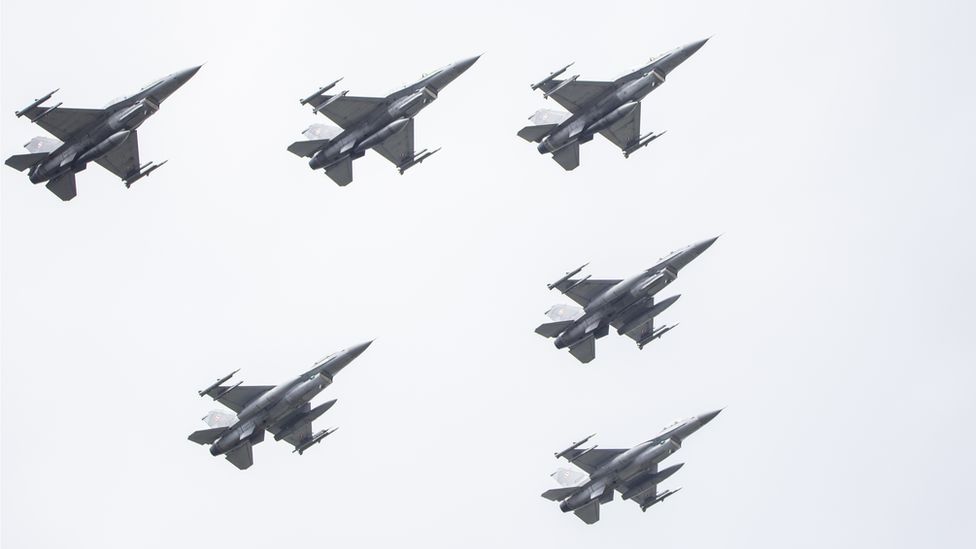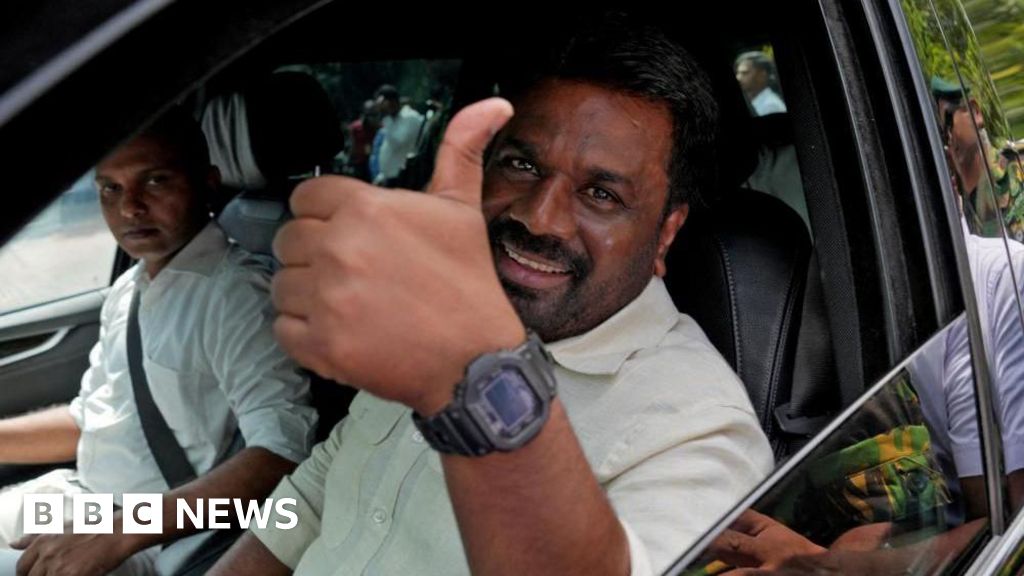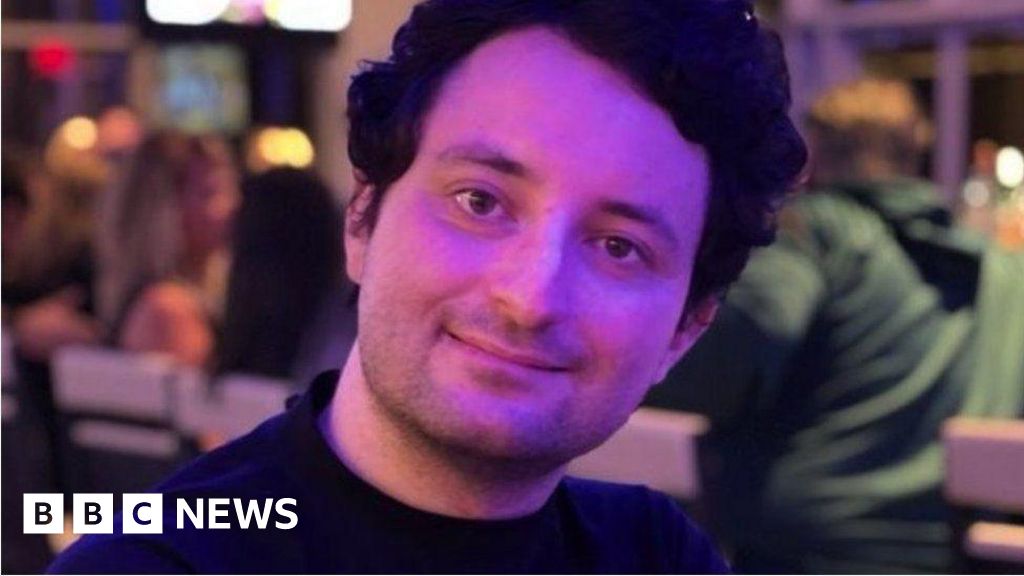ARTICLE AD BOX
 Image source, Getty Images
Image source, Getty Images
President Zelensky has asked for more jets, like these F-16s, to help push back Russia's invasion
Ukraine's President Volodymyr Zelensky spent much of the past week touring European capitals, appealing to leaders to send his country fighter jets.
At the start of Russia's full-scale invasion, Ukraine was believed to have around 120 combat capable aircraft - mainly consisting of aging Soviet-era MiG-29s and Su-27s.
But officials say they need up to 200 jets to match Moscow's air-power - which is thought to be five or six times greater than Kyiv's.
Mr Zelensky is primarily seeking US-made F-16s. First built in the 1970s, the jet can travel at twice the speed of sound and can engage targets in the air or on the ground.
While now eclipsed by the more modern F-35, it remains widely in use. Experts say modern fighters like the F-16 would help Ukraine strike behind Russian lines.
US President Joe Biden has ruled out supplying the jets for now. But countries like Poland and the Netherlands have signalled an openness to supplying Ukraine from their own fleet.
However, Mr Zelensky's request poses a host of practical challenges, that could make an early delivery of such aircraft unlikely. Here's four of them:
Long training times
Ukraine is said to have identified 50 pilots who could begin training on Western jets immediately, but preparing them to fly the warplanes takes time and takes them away from the current fighting.
The British government has agreed to start training Ukrainian pilots on Nato-standard aircraft, but warns that supplying the jets would only ever be a long-term option.
Training pilots could take months or even years, given how complex the fighter jets are. But British officials have said they could speed up the training process for some of Ukraine's more seasoned pilots, who have years of experience flying Soviet-era planes.
Maintenance issues
A fighter jet comes with an entire eco-system to support it. To function in a warzone, it needs complex and specialised engineering - it isn't "a simple case of towing an aircraft to the border," in the words of the UK's Defence Secretary Ben Wallace.
Former Nato official Dr Jamie Shea told the BBC that fourth-generation fighter jets - like the ones requested by Ukraine - require extensive maintenance after almost every flight.
"When I was at Nato and visited an airbase, planes would come back in and the engineers would have to strip out whole systems and put them back in. It's almost like every time you drive your car you have to put a whole carburettor in," Dr Shea said. "So they've got a very high maintenance requirement."
German MP Tobias Bacherle is also concerned that handing over the jets would be a long-term commitment, explaining that the issue is "not only about delivering".
"It's an ongoing engagement, this would be very different to delivering tanks, or delivering anti-aircraft missiles or other heavy weaponry as we've done before", he told the BBC.
Any jets handed over by Nato countries become Ukrainian property so that no Nato personnel are involved directly in the war. But that means Ukrainians must also be trained in maintaining the planes, adding more time to the process.
Wrong type of plane?
There's been speculation that countries like the UK and France could hand over older generations of warplanes to Ukraine, which has ignited some debate over the types of jet that should be provided.
The logistics of different countries sending a variety of old models would be "forbidding", the Economist's defence editor Shashank Joshi told the BBC.
And not all of the newer models suit Ukraine's war needs. Recent generations of the UK's Typhoon jet aren't "optimised for flying at low altitudes, which is what Ukraine has been forced to do because of the Russian air defence threat," Mr Joshi said.
Justin Bronk from the Rusi think tank said giving Typhoons to Ukraine would be a "very expensive symbolic gesture". He observed that most of Ukraine's airbases were dispersed and hidden at the beginning of the war to avoid being targeted by Russian missiles.
The move resulted in Ukraine's air force operating from "relatively austere dispersed airbases" and "short-field" runways with rough surfaces.
UK MP Bob Seely, who served in the UK armed forces, said that Typhoon jets would struggle to operate under such conditions.
"You have to have a plane which is versatile and flexible and can be used when your enemy is bombing your runways and your hangers," Mr Seely told the BBC. "It's got to be a practical offering, my worry is [the Typhoon] is not practical."
Ukraine would need a jet with greater versatility and landing flexibility, like the Swedish-made Gripen jet, he added.
"A Gripen is a reasonably simple plane and very cheap by modern standards, it's good value, it's versatile...it's a useable plane and is useable by the Ukrainians in a relatively short time frame," Mr Seely said.
"It is designed for short take off and to cope with a short rough runway, it comes with kit in a box, almost like an Ikea plane."
Sweden has so far ruled out supplying Gripen jets to Ukraine.
Danger of escalation
Some Nato member countries are worried that handing jets to Ukraine would be viewed as escalating the war, risking a direct confrontation with Russia.
French President Emmanuel Macron said that if France did sent warplanes, he would not want any to be used to "touch Russian soil".
The Kremlin has already made repeated accusations that Nato is an aggressor by proxy, warning on Thursday that the line between direct and indirect Western involvement in the conflict was disappearing.
Dr Shea says a "Rubicon has been crossed" in terms of the more general delivery of weapons to Ukraine in the last few weeks.
Countries "serious about Ukraine winning" need to weigh up the need to provide air cover to the tanks they have supplied to Ukraine, with the risk of escalating the war.
"It doesn't make sense to give Ukraine four members of a five member basketball team and then deny that critical fifth member that makes all the difference," he told the BBC.

 1 year ago
27
1 year ago
27








 English (US)
English (US)